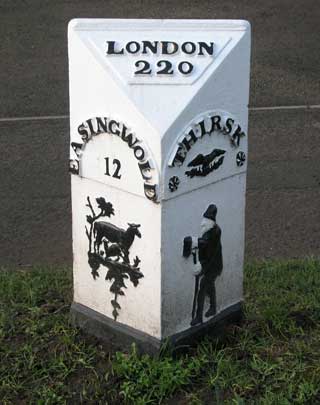Turbary stones
Holme Moss conjures up different images for people: for some it’s an iconic bike ride climb; for others a treacherous moorland road where to venture in the winter is to court danger. But for the residents of the Graveship of Holme the Moss (and ‘moss’ is a local term for a peat-bog) was their source of fuel, and peat was also used for other purposes, eg roofing.
The Graveship of Holme was (in fact still is) a collection of townships around Holmfirth in West Yorkshire. Its origins have nothing to do with burying the dead, but denoted an area governed by a grave or grieve, a mainly northern term for a sheriff. The common lands (in effect the moorlands or mosses) to these townships were divided between the townships, and a glance at older large-scale Ordnance Survey maps reveals a vast number of detached portions of townships all over the moors. These were the sources of peat or turbary (from ‘turf’) for the local population.
“Father Conmee reflected on the providence of the Creator who had made turf to be in bogs where men might dig it out and take it to town and hamlet to make fires in the houses of poor people”. So wrote James Joyce in Ulysses, but turbary or peat-digging rights were jealously guarded. And, because of the featureless nature of the landscapes of these mosses – cf the fruitless searches for the Moors Murderers’ victims – disputes were common. Hence we sometimes find turbary boundary stones.
We have looked, so far without success, for turbary stones around Holme Moss; nor are there any yet located in peat-digging areas of Marsden Moor, just north of Holme Moss – again the proliferation of Moss names indicates the peaty areas. Which is why an unidentified stone on the first Austerlands turnpike above Marsden, which we wanted to be a turbary stone, almost certainly isn’t one.
Further north again, however, there are some stones asserting turbary rights (or ‘commons’) in the township of Langfield in the ancient parish of Halifax. This covers a wide, sparsely-populated area south of Todmorden on the West Riding county boundary. There is no standard pattern to the stones, but all have ‘L’ for Langfield, followed by a number. The one illustrated here says “This common doth belong to L…”, but much on the stones is illegible.
Another area where turbary stones are found is further north again, in the Dales, where turbary rights were often in dispute, especially in the 17th century. They have been recorded in the parishes of Austwick, Dent, Stainforth and Thornton-in-Lonsdale, with the largest number in Lawkland. Many, however, have no visible text. The Yorkshire Dales National Park website has further information, a database on a spreadsheet, and a picture gallery.
For more information on peat and peat cutting see a book of the same title by Ian Rotherham (Shire Publications, 2009). This book is a celebration of a cultural history that extended from the Iron Age to the twentieth century when peat was the main fuel that warmed houses all over the British Isles, and the mark of the peat cutter is written deep in the landscape. It tells the story of the use of peat for fuel in the British Isles, and the people who cut it. It also examines the methods of cutting, the tools that were used, and the organization of cutting. It chronicles the beginning of commercial extraction and the exhaustion of this precious resource.
Sources: Talk given to the Milestone Society Northern Spring Meeting, 2015, by David Garside; Yorkshire Dales National Park website article (archived); Langfield Common stone illustration © Copyright Humphrey Bolton and licensed for reuse under this Creative Commons Licence.
RWH / rev Sept 2020


 On a number of roads in the vicinity of Thirsk in North Yorkshire are some series of milestones that are all very similar in design, although there is no indication on them of who made them.
On a number of roads in the vicinity of Thirsk in North Yorkshire are some series of milestones that are all very similar in design, although there is no indication on them of who made them.